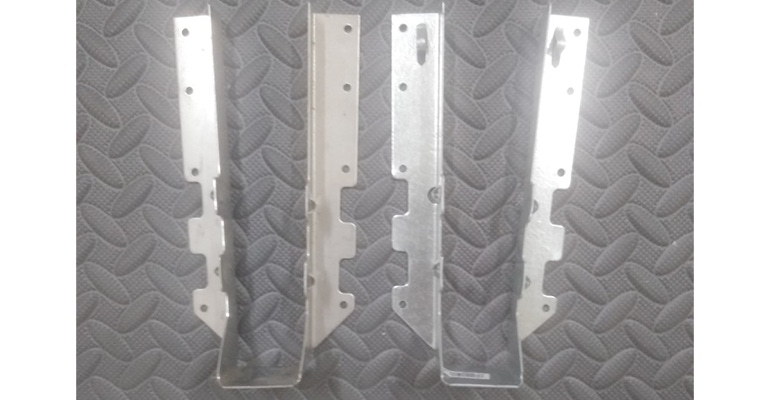Several factors contribute to how fast hardware corrodes.
September 15, 2021

Mike Guertin
Are your deck connectors rusting away?
It's just a matter of time before standard galvanized metal connectors—post bases, post caps, joist hangers, tension ties and hurricane ties—will corrode.
The day you install hardware on a deck it begins corroding.
First the zinc coating corrodes—almost unnoticed. The white zinc oxide corrosion doesn't stand out like the red rust of carbon steel so people don't take notice.
But when the zinc coating breaks through exposing the carbon steel beneath the corrosion leads to structural deterioration.
When you build a deck in a corrosive environment it may be worthwhile to install stainless steel hardware to ensure the deck lasts a good long time.
Several factors contribute to how fast hardware corrodes.
Water/Moisture: Rain, snow meltwater, condensation and humidity—the more water that comes in contact with the hardware and longer it takes to dry when it gets wet, the faster it can corrode. This means areas with higher precipitation and humidity have an increased risk of corrosion. In general, these would be areas east of the Mississippi River, Gulf Coast, Pacific Northwest and parts of the Mountain West.
Acid rain and dry deposition of acidic particles: We don't hear about acid rain in the news as much as we did in the '70s and '80s but areas downwind of fossil fuel power plants still receive rain with lower pH which accelerates corrosion. The effects can be localized but there's a broad area where acid rain is more pronounced. East of the Mississippi River and North of the Tennesee/Kentucky/Virginia/North Carolina borders.
Proximity to saltwater: Salt accelerates corrosion and the deck doesn't need to be beachfront to suffer the effects of ocean proximity. Wind can circulate salt from shoreside areas from several hundred feet to many miles inland. Pacific Coast, Atlantic Coast, Gulf of Mexico Coast, and Gulf of St. Lawrence Coast.
Proximity to roadways treated with snowmelt chemicals: Sodium chloride, calcium chloride and other snowmelt treatments applied by highway departments are picked up by wind and turbulent air generated by vehicle traffic after the snowmelt water dries. The salt dust settles on decks near these roadways and accelerates corrosion.
Snowmelt chemicals applied to decks: Homeowners rarely realize the impact of the salt they apply on their decks. They spread deicing chemicals to prevent slip hazards from snow and ice on their decks and stairways, and without realizing it they create another hazard—corroding hardware.
Pool and spa chemicals: If a deck is close enough to a pool or spa to be wet by splashing or water dripping off people then the hardware will suffer an increased chance of corrosion.
Contact with pressure-treated lumber: There are different treatment chemicals and some are more corrosive than others. The galvanic reaction between the copper in many lumber treatments accelerates corrosion of the zinc and steel of regular hardware. UC3B (Above Grade) treated lumber is less corrosive than UC4A (Ground Contact-Regular duty).
I work in one of the most corrosive areas of North America and discuss the stainless steel option with clients when costing out new decks. The beauty of stainless steel hardware is it doesn't corrode but it does cost more—a lot more. I roughly figure stainless hardware costs 10 times what galvanized hardware costs. That can take a $1,000 galvanized hardware budget line to $10,000 for stainless—a number that will shock most clients.
So how do you make the judgment whether you should recommend stainless steel hardware on a particular deck or regular galvanized? It's easy if you build in the desert Southwest—regular galvanized is fine. And it's an easy choice for a deck on a seaside house in the Northeast—stainless steel. A pool deck—stainless steel. But when the deck is exposed to just a couple of corrosion-contributing factors the choice can be hard.
There's a little guidance in the 2021 IRC. Table R507.2.3 requires a minimum galvanization of G185 (2 oz. of zinc coating per square foot—total both sides) on metal hardware unless the deck is exposed to saltwater or within 300 ft of saltwater shoreline—then stainless steel hardware is required.
Simpson Strong Tie has a document "Guidelines for Selecting the Proper Materials and Coatings" that recommends using stainless steel hardware in areas with High and Severe corrosion potential.
Ultimately the risk of deck hardware corroding is the deck will collapse and people will be hurt. Fortunately, there aren't a lot of deck collapses solely due to hardware corrosion. Hardware deteriorates slowly over time. Ideally, the owners should have their decks inspected annually and checked for red rust on metal hardware.
Mike Guertin has written hundreds of articles for publications such as Fine Homebuilding, the Journal of Light Construction and Professional Deck Builder as well as authoring several books. He's also known for his how-to videos and live events at venues such as JLC Live, the Remodeling Show, IBS, IRE and other trade shows along with numerous lumberyard events.
You May Also Like


